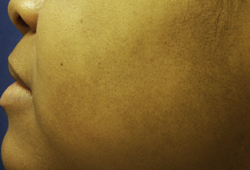History and exam
Key diagnostic factors
common
centrofacial, malar, or mandibular distribution of muddy brown to gray hyperpigmentation
Muddy brown to gray hyperpigmentation in a typical distribution (i.e., centrofacial, malar, mandibular) suggests a diagnosis of melasma. The central facial pattern is the most common pattern seen; however, hyperpigmentation can sometimes affect different areas, such as the forearms and neck.[3][Figure caption and citation for the preceding image starts]: MelasmaFrom the collection of Dr Laura Ferris [Citation ends].
Risk factors
strong
female sex
Fitzpatrick III-VI skin types
ultraviolet radiation
Melasma is exacerbated following sun exposure and fades with sun protection.[3]
oral contraceptive pill
Any estrogen-containing drug may cause melasma, including transdermal hormones and hormone replacement therapy (HRT). Melasma is seen more frequently in women who use oral contraceptives.[16]
pregnancy
Up to 60% of pregnant women will develop melasma, with it being more common in the third trimester.[16] This phenomenon can be explained by the association between increased levels of melanin-stimulating hormone (MSH), postinflammatory phenomenon, and ultraviolet light exposure in pregnant women.[10]
Use of this content is subject to our disclaimer